It would be hard to overstate the impact of the railroad on Fort Worth history. And it would be hard to overstate the impact of the decade of the 1880s on Fort Worth railroad history. During that decade Fort Worth would add ten railroads; its population would grow from 6,663 to 23,076.
In fact, for Cowtown the 1880s would be as fat as the 1870s had been lean.
 It had all seemed so promising in 1872. On September 14, 1872 the Dallas Weekly Herald had reported that Tarrant County had approved a $100,000 ($2 million today) subsidy to the Texas & Pacific railroad. T&P was laying track westward from Longview to Dallas. Fort Worth wanted the track extended thirty miles west.
It had all seemed so promising in 1872. On September 14, 1872 the Dallas Weekly Herald had reported that Tarrant County had approved a $100,000 ($2 million today) subsidy to the Texas & Pacific railroad. T&P was laying track westward from Longview to Dallas. Fort Worth wanted the track extended thirty miles west.

In fact, on March 22, 1873, the Weekly Herald reported surveying of the route from Dallas to Fort Worth and predicted that trains would be running from Fort Worth to Shreveport by Christmas. The Weekly Herald said the line from Dallas to Fort Worth could cost $35,000 ($700,000 today) a mile because of extensive bridge and rock work.
 By August 1873 the T&P was ready to serve Dallas. (Dallas’s first railroad, the Houston & Texas Central, had begun service in 1872.) The community of Brooklyn was later renamed “Forney.”
By August 1873 the T&P was ready to serve Dallas. (Dallas’s first railroad, the Houston & Texas Central, had begun service in 1872.) The community of Brooklyn was later renamed “Forney.”
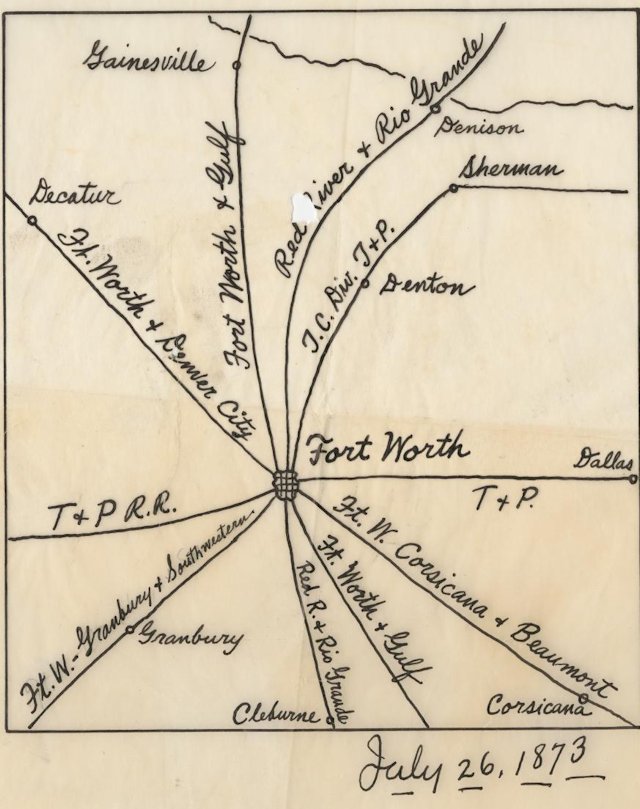
Fort Worth was optimistic. The future was just thirty miles to the east now. And the T&P would be just the start for Fort Worth. In fact, in 1873 B. B. Paddock, then editor of the Fort Worth Democrat and the town’s foremost “I think we can, I think we can” booster, drew his ambitious “tarantula map” projecting that Fort Worth would one day be a railroad center. (Some of the railroad lines shown on Paddock’s map never materialized.)(Photo from University of Texas at Arlington Library.)
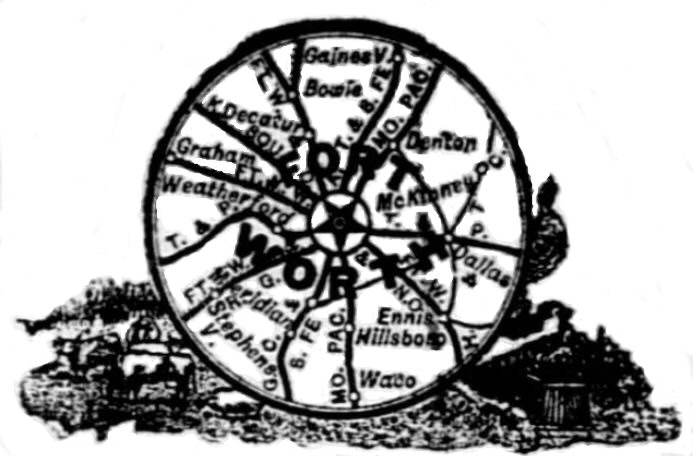 (In 1887 the Democrat would add this updated version of Paddock’s map to its nameplate. Some of the railroads shown in the maps never materialized.)
(In 1887 the Democrat would add this updated version of Paddock’s map to its nameplate. Some of the railroads shown in the maps never materialized.)
But in September 1873 came a national economic panic, and the California and Texas Railway Construction Company, which the T&P was paying to lay the track, failed. Fort Worth would wait three long years for those thirty short miles of track. Finally, on July 19, 1876, Fort Worth got its first whiff of coal smoke as T&P locomotive 20 rambled into town. With that arrival T&P had attached the first leg to Paddock’s tarantula map.
 On December 14, 1877, while Fort Worth’s tarantula map still had but one leg, the Dallas Daily Herald poked fun at Paddock and Cowtown’s aspirations. Note that the news story says that an enlargement of Paddock’s tarantula map was posted on the courthouse square.
On December 14, 1877, while Fort Worth’s tarantula map still had but one leg, the Dallas Daily Herald poked fun at Paddock and Cowtown’s aspirations. Note that the news story says that an enlargement of Paddock’s tarantula map was posted on the courthouse square.
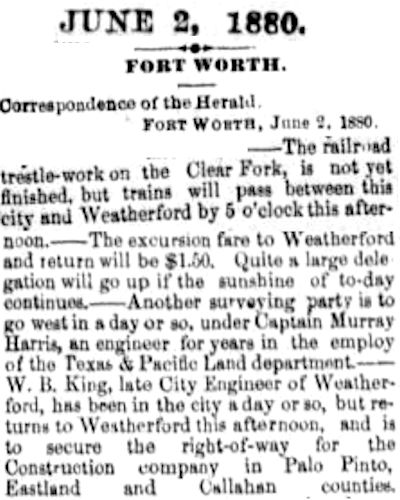
Fort Worth would have to wait three more years—until the beginning of the grand decade of the 1880s—for its second leg. For three years Fort Worth had had to watch as the coming of the railroad in 1873 had transformed Dallas just thirty miles to the east. But Benbrook, Weatherford, and points west of Fort Worth had to wait seven years. After the railroad reached Fort Worth in July 1876, not until April 1880 did T&P continue laying track westward, reaching Weatherford on June 2. Meanwhile surveying and acquisition of right-of-way would extend into Palo Pinto, Eastland, and Callahan counties. Clip is from the Dallas Herald.
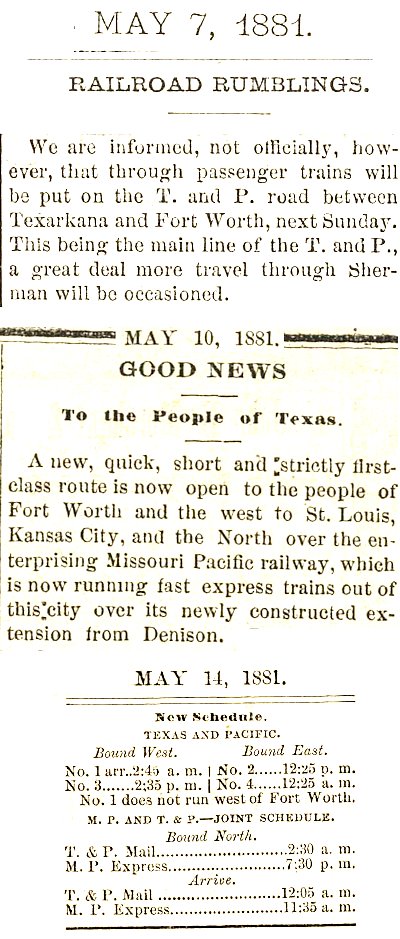
The next year, 1881, was monumental in Fort Worth’s rail history. In May the T&P opened a track north from Fort Worth to Sherman. The tarantula got a third leg. But this leg was a twofer: Not only the T&P but also the Missouri Pacific railroad began serving Fort Worth on that track.
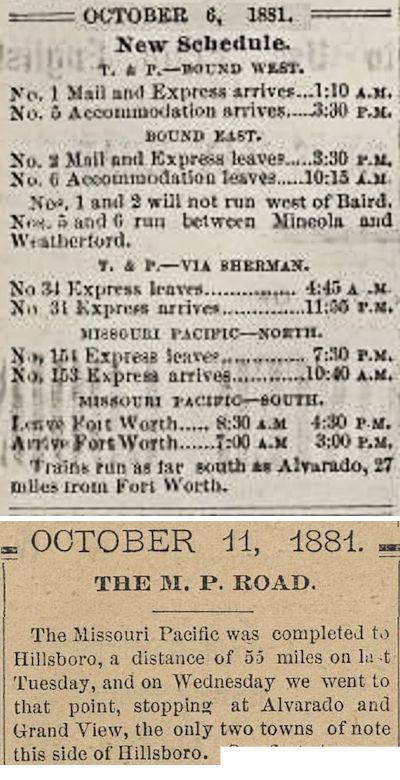 And in October the Missouri Pacific began serving Fort Worth from the south.
And in October the Missouri Pacific began serving Fort Worth from the south.
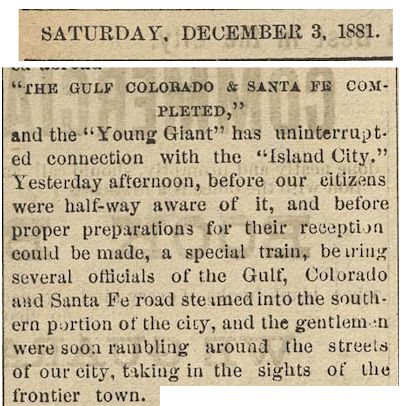 And the Santa Fe began service from the south in December 1881. “Young Giant” was one of the Democrat’s nicknames for Fort Worth.
And the Santa Fe began service from the south in December 1881. “Young Giant” was one of the Democrat’s nicknames for Fort Worth.
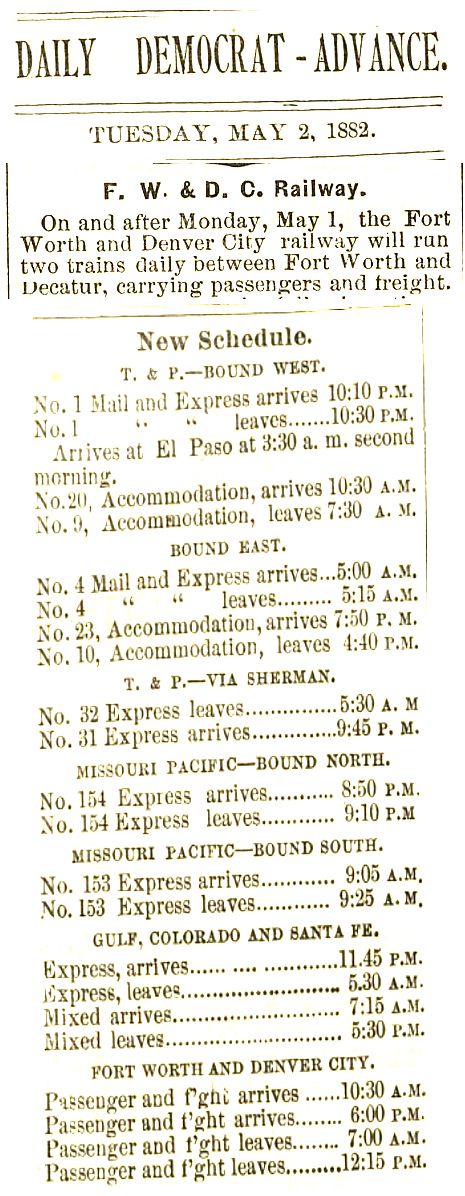 In May 1882 the Fort Worth & Denver City railroad began service, if only to Decatur, not Denver.
In May 1882 the Fort Worth & Denver City railroad began service, if only to Decatur, not Denver.
Also that year, to accommodate the new railroads, T&P built its Union Depot where the T&P track crossed the Santa Fe and Missouri Pacific tracks at today’s Tower 55.
In 1886 came the Fort Worth & New Orleans.
in 1887 the Santa Fe extended service to the north, becoming the eighth leg of Paddock’s map. Paddock’s 1873 arachnidian vision was anatomically correct.
Also in 1887 the Fort Worth & Rio Grande began service to Granbury. In 1888 the Fort Worth & Denver City finally reached Denver, and the St. Louis, Arkansas & Texas (Cotton Belt) began service, the tenth of the decade.
 The year 1888 brought a minor turning point in Fort Worth railroad history, as shown in these two railroad time tables in the Daily Gazette. Since 1880 tycoon Jay Gould had leased the Missouri, Kansas & Texas (Katy) railroad and operated it as the Katy division of his Missouri Pacific railroad. In 1888 the lease expired, and the Katy reverted to independent operation under its own name.
The year 1888 brought a minor turning point in Fort Worth railroad history, as shown in these two railroad time tables in the Daily Gazette. Since 1880 tycoon Jay Gould had leased the Missouri, Kansas & Texas (Katy) railroad and operated it as the Katy division of his Missouri Pacific railroad. In 1888 the lease expired, and the Katy reverted to independent operation under its own name.
 The 1889 time table.
The 1889 time table.
 A few weeks after barely mentioning the arrival of the Missouri Pacific in Cowtown, the Dallas Weekly Herald suffered this rare spasm of bonhomie about Fort Worth and its railroads.
A few weeks after barely mentioning the arrival of the Missouri Pacific in Cowtown, the Dallas Weekly Herald suffered this rare spasm of bonhomie about Fort Worth and its railroads.
The railroads changed everything for every city they laid rail to. Even as early as 1876, when Fort Worth still had but one railroad, it was connected to the world because the T&P connected Fort Worth to Dallas. People in Fort Worth could board a train at the Texas & Pacific passenger depot at the foot of Main Street and via connections to other railroads go almost anywhere. Now people in Fort Worth could reach New York City and the steamship lines of the Atlantic. People in Fort Worth could sail across the ocean to the country where they or their parents were born! And the connection worked both ways: Now people from far-away places could take the train to Fort Worth. The railroads made Cowtown more cowsmopolitan.
 Trains moved fast, had ice-cooled cars, so food that was shipped by rail stayed fresher. And the railroad brought cold beer to town.
Trains moved fast, had ice-cooled cars, so food that was shipped by rail stayed fresher. And the railroad brought cold beer to town.
Cattle could be shipped to market in rail cars, not on the cattle trails. The railroads carried letters, newspapers, books, parcels, increasing the speed with which people could communicate and share information. The railroads were the Internet of the nineteenth century, running on iron rails instead of fiber optics.






“Cowsmopolitan?”
What can I say, Steve? Blogging has no shame.